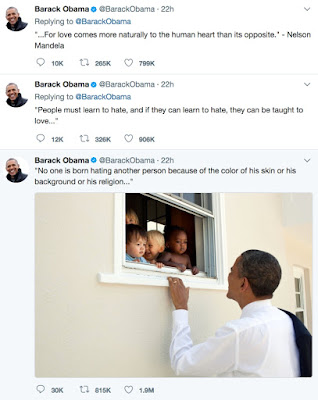Wednesday, August 30, 2017
Go Fly A Kite
Lots of wind today from the northwest. Hope it holds up for next week's Martha's Vineyard Wind Festival.
Tuesday, August 22, 2017
The Day After the Solar Eclipse
Wasn't the eclipse a welcome astronomical diversion?
Except at The New Yorker. They didn't miss a beat.
Except at The New Yorker. They didn't miss a beat.
 |
| The New Yorker ~ Kim Warp |
 |
| The New Yorker ~ Ellis Rosen |
Labels:
Donald Trump,
Ellis Rosen,
Kim Warp,
politics,
The New Yorker,
total solar eclipse
Wednesday, August 16, 2017
Solar Eclipse Hysteria
Solar eclipse hysteria is upon us with news reports about profiteers selling fake safety glasses and Amazon giving refunds, and the American Academy of Ophthalmology and American Astronomical Society warning about the risks of eye damage.
Google Trends illustrates that searches about the eclipse, especially "interest by region," mirrors the path of totality.
The Wall Street Journal reports that Jackson, Wyoming, will be swarmed with crowds as it falls right in the path: Oh No, Here Come the Solar Eclipse Hordes.
Even the 1st Interstate Motel nearly 300 miles away in Casper, Wyoming has gotten into act, commanding well over $1,000 per night for rooms that usually book for under $100.
Easily the most witless and ridiculed example of eclipse hysteria was the article by Matt Rocheleau at the Boston Globe that strained much too hard to connect the path of totality to Trump voters: The Solar Eclipse Path Will Overwhelmingly Pass Over Trump Country.
For better or worse, the 70-mile-wide swath of eclipse totality could be anywhere and still overwhelmingly pass over Trump Country. Something tells me the Sun and Moon have always risen above politics.
Google Trends illustrates that searches about the eclipse, especially "interest by region," mirrors the path of totality.
 |
| Google Trends |
Even the 1st Interstate Motel nearly 300 miles away in Casper, Wyoming has gotten into act, commanding well over $1,000 per night for rooms that usually book for under $100.
Easily the most witless and ridiculed example of eclipse hysteria was the article by Matt Rocheleau at the Boston Globe that strained much too hard to connect the path of totality to Trump voters: The Solar Eclipse Path Will Overwhelmingly Pass Over Trump Country.
 |
| Boston Globe |
Sunday, August 13, 2017
Learn to Love
Labels:
Antifa,
Barack Obama,
BLM,
diversity,
hate,
identity politics,
inclusion,
KKK,
love,
Nazis,
Nelson Mandela,
Twitter
Monday, August 7, 2017
Thursday, August 3, 2017
Crispr-Cas9
Remember Mr. DNA, the cartoon character in the movie Jurassic Park, who explains how the park's scientists extract and edit DNA from mosquitoes trapped in amber millions of years ago to bring extinct dinosaurs back to life? Remember chaos theory?
Well, gene editing is now quite real where not a day goes by when something new is reported about the advances - - and moral and ethical issues - - of gene editing.
I first learned about the gene editing tool Crispr, short for clustered regularly interspaced short palindromic repeats, last May when Wired published a video with biologist Neville Sanjana. Sanjana explained the tool, first to a seven-year-old, followed by a fourteen-year-old, a college student, a grad student, and finally a Crispr expert. It's fascinating technology with far-ranging implications and consequences for the human race.
Gene editing holds great promise for preventing the heritability of many diseases caused by DNA mutations, such as autism, diabetes, and cancer.
The Wall Street Journal reported yesterday on the latest breakthroughs in gene editing in viable human embryos, as well as the race to patent and profit from the market opportunities ahead.
Laws governing the U.S. Food and Drug Administration prohibit the funding and testing of "germ-line" editing, but other countries are not bound by American laws or ethical standards.
Wealth will drive the new world of privilege and access to gene editing and embryo modification.
Welcome to Gattaca.
Well, gene editing is now quite real where not a day goes by when something new is reported about the advances - - and moral and ethical issues - - of gene editing.
I first learned about the gene editing tool Crispr, short for clustered regularly interspaced short palindromic repeats, last May when Wired published a video with biologist Neville Sanjana. Sanjana explained the tool, first to a seven-year-old, followed by a fourteen-year-old, a college student, a grad student, and finally a Crispr expert. It's fascinating technology with far-ranging implications and consequences for the human race.
Gene editing holds great promise for preventing the heritability of many diseases caused by DNA mutations, such as autism, diabetes, and cancer.
The Wall Street Journal reported yesterday on the latest breakthroughs in gene editing in viable human embryos, as well as the race to patent and profit from the market opportunities ahead.
"The technology has sparked a rush of investment into companies poised to take advantage of Crispr. Hundreds of millions of dollars have been invested in for-profit startups founded by scientists whose academic institutions are now warring with each other over the patent."The moral and ethical issues center on "germ-line" editing of the genes in sperm, eggs and embryos. Such editing not only alters the DNA of an individual, but its offspring and future generations, creating legal issues around consent of the unborn. It also presents the future of "designer babies" where physical attributes like hair and eye color, and height and strength, become genetic choices.
Laws governing the U.S. Food and Drug Administration prohibit the funding and testing of "germ-line" editing, but other countries are not bound by American laws or ethical standards.
Wealth will drive the new world of privilege and access to gene editing and embryo modification.
Welcome to Gattaca.
Labels:
chaos theory,
Crispr,
Crispr-Cas9,
ethics,
Gattaca,
gene editing,
Jurassic Park,
morals,
Mr. DNA,
Neville Sanjana,
P53 mutations
Subscribe to:
Comments (Atom)





